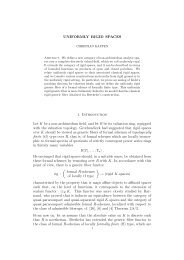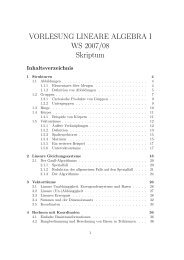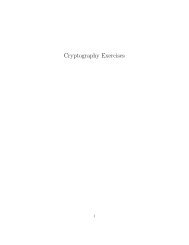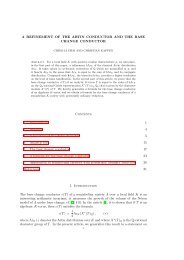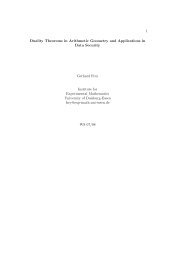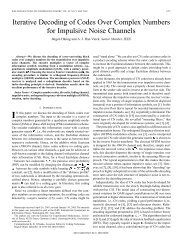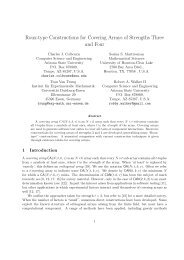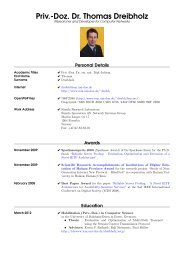Proposition 36 Let E/K be a <strong>CM</strong> <strong>elliptic</strong> curve. If E 1 , . . . , E n ∈ Isog(E/K), thenthere is an <strong>elliptic</strong> curve E ′ ∼ E such that f E ′ = lcm(f E1 , . . . , f En ).Pro<strong>of</strong>. By induction, it is clearly enough to verify the case n = 2.Since E i ∼ E, we can view R i := End(E i ) as a subring <strong>of</strong> F = End 0 (E) whichis uniquely determined by the condition that [O F : R i ] = f Ei . Put R ′ = R 1 R 2 andf i = [R ′ : R i ]. Since R ′ has conductor f = (f E1 , f E2 ) by (37), we see that (f 1 , f 2 ) = 1.Note that char(K) ∤ f i = 1 by Proposition 33(b).Next, consider the R i -ideal I i = f i R ′ and put π i = π H(Ii ) : E i → E i ′ = (E i ) H(Ii ).Since by (45) we have E(H(I i )) ≃ R(I i ) = R(f i R ′ ) = R ′ , it follows from Remark20 that there is an invertible R ′ -ideal I such that (E 1) ′ H(I) ≃ E 2. ′ Furthermore, byreplacing I by cI if necessary (where c ∈ F × ), we can assume that (N(I), f 1 ) = 1 andthat char(K) ∤ N(I).Put H 1 = Ker(π 1) ′ and H 2 = Ker(π 2 ◦ π H(I) ). Clearly (E 1) ′ Hi ≃ E i , and so E(H i ) ≃R i ⊂ R ′ ≃ End(E 1). ′ Furthermore, |H 1 | = deg(π 1) ′ = deg(π 1 ) = f 1 , and |H 2 | =deg(π 2) ′ deg(π H(I) ) = f 2 N(I), so (|H 1 |, |H 2 |) = 1. In addition, we have that char(K) ∤|H i |. Thus, by Proposition 29 we have E(H 1 + H 2 ) = E(H 1 ) ∩ E(H 2 ) = R 1 ∩ R 2 , whichhas conductor lcm(f E1 , f E2 ) by (37). Thus (E 1) ′ H1 +H 2has conductor lcm(f E1 , f E2 ), andso the assertion follows because E ∼ E 1 ′ ∼ (E 1) ′ H1 +H 2.3.4 The quadratic form q E1 ,E 2Let E 1 /K and E 2 /K be any two isogenous <strong>elliptic</strong> <strong>curves</strong>, and putq E1 ,E 2(f) = deg(f), for f ∈ Hom(E 1 , E 2 ).Since Hom(E 1 , E 2 ) ≃ Z r , where r = rank(Hom(E 1 , E 2 )) = dim Q (End 0 (E i )), we seethat by fixing a basis <strong>of</strong> Hom(E 1 , E 2 ), we obtain an explicit positive definite quadraticform in r variables. Thus, by varying over all bases <strong>of</strong> Hom(E 1 , E 2 ), we obtain aGL r (Z)-equivalence class <strong>of</strong> quadratic forms in r variables.In the case that E i is a <strong>CM</strong> <strong>elliptic</strong> curve, we have r = [F : Q] = 2, so q E1 ,E 2definesan equivalence class <strong>of</strong> positive binary quadratic forms, i.e. q E1 ,E 2∼ ax 2 +bxy+cy =: q,for some a, b, c ∈ Z with ∆(q) = b 2 − 4ac < 0. Note that the discriminant ∆(q) andthe content cont(q) = gcd(a, b, c) are invariants <strong>of</strong> the GL 2 (Z)-equivalence class <strong>of</strong> q.In order to determine q E1 ,E 2, we introduce the following notation. Given a latticeL ∈ Lat F , where F is an imaginary quadratic field, putq L (λ) = N(λ) , for λ ∈ L,N(L)where, as before, N(λ) = N F/Q (λ) denotes the field norm. Note that q L (λ) ∈ Z; cf.[3], §II.7. Thus, by choosing a basis {α, β} <strong>of</strong> L = Zα + Zβ, the map q L defines an30
integral quadratic formq L,α,β (x, y) = q L (xα + yβ), for x, y ∈ Z,and hence q L defines an equivalence class <strong>of</strong> positive binary quadratic forms. Moreover,we have by [3], §II.7 that(78)∆(q L ) = ∆(R(L)) and cont(q L ) = 1.We now prove:Proposition 37 Let E/K be a <strong>CM</strong> <strong>elliptic</strong> curve and E 1 , E 2 ∈ Isog + (E). If f i = f Ei ,then(79)q E1 ,E 2∼ cq L , where L = I E (E 1 )I E (E 2 ) −1 and c = lcm(f 1, f 2 )gcd(f 1 , f 2 ) .In particular, c = cont(q E1 ,E 2) and(80)∆(q E1 ,E 2) = −lcm(|∆ E1 |, |∆ E2 |) = lcm(f 1 , f 2 ) 2 ∆ F , where F = End 0 (E).Pro<strong>of</strong>. Let π i : E → E i be an isogeny and put H i = Ker(π i ) and n i = deg(π i ).Moreover, put Φ = Φ H1 ,H 2and H = H(H 1 , H 2 ). We first show that(81)q E1 ,E 2(h) = cq H (Φ(h)), for all h ∈ Hom(E 1 , E 2 );here we used the identification E i = E Hi .Since the H i ’s are ideal subgroups by (46), we have by (57) that N(L) = c n 1n 2.Moreover, since we have by (54) that deg(f) = N(f), for all f ∈ R = End(E),we see from the definition <strong>of</strong> Φ that N(Φ(h)) = N( 1 n 2π 2 hπ 1 ) = 1 deg(πn 2 2 hπ 1 ) =21deg(πn 2 2 ) deg(h) deg(π 1 ) = n 12n 2deg(h), and soq E1 ,E 2(h) = deg(h) = n 2n 1N(Φ(h)) = c N(Φ(h))N(H) , for h ∈ Hom(E 1, E 2 ).This proves (81) and hence also (79) because by (47) and (41) we have that H =(I(H 1 ) : I(H 2 )) = f 1I(H f 1)I(H 2 ) −1 = f 1L, and so q f H ∼ q L .Since q L is primitive by (78), we have from (79) that cont(q E1 ,E 2) = c · cont(q L ) =c. Moreover, by (78) we have that ∆(q L ) = ∆(R(L)). Now since R(I(H i )) =E(H i ) ≃ End(E i ) has conductor f i , it follows from (39) and (37) that R(L) =R(I(H 1 ))R(I(H 2 )) has conductor f = (f 1 , f 2 ), and so ∆(q L ) = f 2 ∆ F . Thus wesee that ∆(q E1 ,E 2) = c 2 ∆(q L ) = (cf) 2 ∆(f) = lcm(f 1 , f 2 ) 2 ∆ F , and so (80) follows.31
- Page 1: Products of CM elliptic curves1 Int
- Page 7 and 8: Indeed, if If is a kernel ideal, th
- Page 9 and 10: Indeed, by (18) we have I 1 f = I 2
- Page 11 and 12: Proof. To prove (29), let h ∈ Hom
- Page 13 and 14: 2.4 The quadratic caseWe now specia
- Page 15 and 16: ecause here f 2 |f 1 , so f = f 2 a
- Page 17 and 18: For this, put f = [R ′ : R], I =
- Page 19 and 20: From (54) we can conclude that(55)d
- Page 21 and 22: If H is any finite subgroup scheme
- Page 23 and 24: E. As we shall see, it is very illu
- Page 25 and 26: From this we see on the one hand th
- Page 27 and 28: Proposition 30 Let L ∈ Lat F , wh
- Page 29: (b) Deuring[10], p. 263. Note that
- Page 33 and 34: Corollary 39 Let E 1 /K and E 2 /K
- Page 35 and 36: Proof. Write π i = π Hi : A → A
- Page 37 and 38: (a) The order R is cyclic if and on
- Page 39 and 40: for k = 1, . . . , n − 2. Moreove
- Page 41 and 42: 4.3 Products of CM elliptic curvesW
- Page 43 and 44: Corollary 56 Let E/K be a CM ellipt
- Page 45 and 46: Case 2. char(K) = 0.As was mentione
- Page 47 and 48: Let h A/K (X) ∈ Z[X] (respectivel
- Page 49 and 50: Proof. To prove this, we shall use
- Page 51 and 52: where xy denotes the quadratic form
- Page 53 and 54: denote the set of isomorphism class



